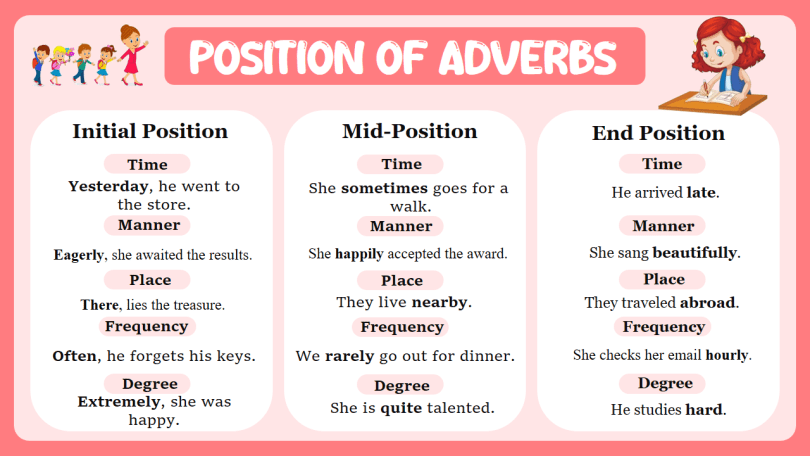Position of adverbs to make sentences sound just right. Knowing where to put these little words is important. Adverbs in grammar can go in three main spots: at the start, in the middle, or at the end of a sentence. When they’re at the start, they catch attention. In the middle, they fit in smoothly with what’s happening. And in the end, they finish things off nicely. Understanding these spots helps people make sentences that sound great and make sense.

Position Of Adverbs In English with Examples Sentences
Position Of Adverbs Definition:
The position of adverbs refers to where they are placed within a sentence. They add a little bit of extra detail about actions, like how something can be done, when it happens, or where it will take place. Their position is something like sometimes they like to be right at the start of a sentence, sometimes in the middle, and sometimes they prefer to wrap things up at the end. It all depends on where they fit best to make the sentence sound just right.
Use Position of Adverbs:
In the use, where to put adverbs is like knowing where each piece fits in a puzzle. Some adverbs like to be at the start to catch attention. Others prefer the middle to add more details. And some like to wrap things up at the end to leave a strong impression. It’s like a game of putting things in the right place to make your writing sound great! For Example:
She always sings loudly.
Tomorrow, we’ll go swimming.
He eagerly opened the gift.
Three main Positions of Adverb:
Beginning Position:
if adverbs are placed at the beginning of a sentence or phrase, they often serve a particular aspect of the action or situation described in the sentence. This position can draw immediate attention to the adverb and the information it conveys, setting the tone for what follows in the sentence. For Example:
Tomorrow, we’ll visit the museum.
He always arrives early for meetings.
Middle Position:
Adverbs in the middle position are like subtle additions to a sentence. They come right after the main verb and help to give more detail about how the action is performed. This position allows them to seamlessly blend into the sentence structure, enhancing the meaning without overshadowing the main message. For Example:
He usually eats breakfast at 8 a.m.
The dog barked loudly in the yard.
End Position:
In this position, we place adverbs at the end of a sentence or clause. Adverbs provide final information about the action, manner, time, or frequency described in the sentence. Placing an adverb at the end can add emphasis or clarity to the meaning of the sentence. For Example:
She danced gracefully.
He speaks Spanish fluently.
Position Of Adverbs Examples:
- Quickly, she ran.
- He carefully placed the vase.
- They eagerly awaited.
- Lazily, the cat stretched.
- We patiently waited.
- Enthusiastically, the teacher praised.
- The bird gracefully soared.
- Quietly, they tiptoed.
- Nervously, she tapped.
- Confidently, he presented.
You May Also like this
- Adverbs of Manner with Examples
- Types of Adverbs in English
- Adverb of Degree in Grammar
- Adverbial Phrase with List








Leave a Comment